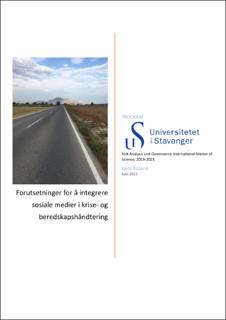| dc.description.abstract | The purpose of this study has been to identify organisational, technological and human prerequisites for organizations integrating the use of social media in their crisis- and emergency preparedness management.
Through the investigation of four Norwegian organisations, I tried to find answers to the research question:
Which prerequisites must be present in order to integrate social media into crisis- and emergency management?
The research methodology was qualitative, and data were collected through document analyses and semi-structured interviews with the four organisations. Because crisis communication involves organisational, technological and human factors, I chose to discuss and present the findings along an MTO axis.
Main findings are:
• Organisation:
o The use of social media in crisis- and emergency management requires alterations to roles and responsibilities. It is resource-intensive with regards to human resources and ultimately economy. A strategic understanding of its use is mandatory throughout the organisation, including at senior level.
o Resources: Dedicated staff are required to handle social media in all crisis phases, including daily operations, and the personnel and technological investments should be accepted.
• Technology:
o Investments in technology is necessary for monitoring of social media in order to sort data and make sense of the huge mass of information.
• Human resources:
o Crisis- and emergency preparedness organisations must have staff with specific competence in the use of social media. Further, organisations must have an understanding of the power and dynamics these media to be able to exploit the opportunities and avoid misleading use during crisis communication.
My research points to the following suggestions to advance further integration of social media into crisis- end emergency management:
• Organisation:
o The issue of integration should be lifted out of individual organisations into a broader public context which, for example, involves public emergency services and regulators, amongst others.
o Organisations must develop and implement methods and procedures to assess the trustworthiness of citizen-generated data.
o Organisations should develop performance measures, standard operating procedures (SOPs), best practices and performance requirements in order to achieve consistent use.
o Social media should be incorporated into regular emergency management training programmes and exercises.
• Technology:
o Better and more effective technology for media monitoring should be made accessible, contributing to improved situational awareness.
o Developing adaptive social media platforms tailored for crisis- and emergency management could be considered. These media should attend to the organisations’ functional demands and still appeal to the public.
o A more holistic approach to crisis management technology should be assumed, facilitating a tighter and more seamless integration of different systems.
• Human resources:
o Organisations should build competence in the use of social media as a specific crisis management tool and not base their use during crises solely on experience gained during daily operations. | |
